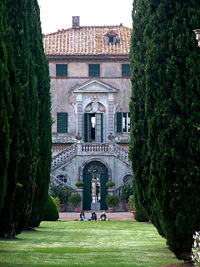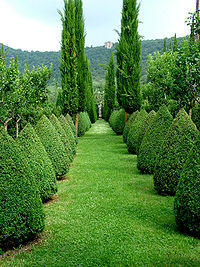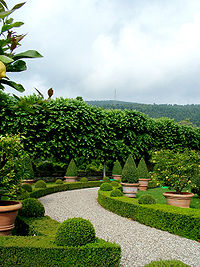
Villa Cetinale
Encyclopedia



Tuscany
Tuscany is a region in Italy. It has an area of about 23,000 square kilometres and a population of about 3.75 million inhabitants. The regional capital is Florence ....
, Italy
Italy
Italy , officially the Italian Republic languages]] under the European Charter for Regional or Minority Languages. In each of these, Italy's official name is as follows:;;;;;;;;), is a unitary parliamentary republic in South-Central Europe. To the north it borders France, Switzerland, Austria and...
, located in the hamlet of Cetinale near Sovicille
Sovicille
Sovicille is a comune in the Province of Siena in the Italian region Tuscany, located about 60 km south of Florence and about 10 km southwest of Siena....
and about 12 km west of Siena
Siena
Siena is a city in Tuscany, Italy. It is the capital of the province of Siena.The historic centre of Siena has been declared by UNESCO a World Heritage Site. It is one of the nation's most visited tourist attractions, with over 163,000 international arrivals in 2008...
.
The villa, originally called Villa Chigi, was built by Cardinal Flavio Chigi
Flavio Chigi (1631-1693)
thumb|250px|Cardinal Flavio ChigiFlavio Chigi was an Italian Catholic Cardinal and Duke of Ariccia. He was Cardinal-Nephew to Pope Alexander VII and became a powerful political force inside the Roman Catholic Church during the latter half of the 17th century.-Early life:Flavio Chigi was born 10...
, Prince of Farnese, Duke of Ariccia
Ariccia
Ariccia is a town and comune in the Province of Rome, central Italy. It is in the Alban Hills of the Lazio region and could be considered an extension of Rome's southeastern suburbs...
and Prince of the Holy Roman Empire
Holy Roman Empire
The Holy Roman Empire was a realm that existed from 962 to 1806 in Central Europe.It was ruled by the Holy Roman Emperor. Its character changed during the Middle Ages and the Early Modern period, when the power of the emperor gradually weakened in favour of the princes...
, nephew of Pope Alexander VII
Pope Alexander VII
Pope Alexander VII , born Fabio Chigi, was Pope from 7 April 1655, until his death.- Early life :Born in Siena, a member of the illustrious banking family of Chigi and a great-nephew of Pope Paul V , he was privately tutored and eventually received doctorates of philosophy, law, and theology from...
. He employed Carlo Fontana
Carlo Fontana
Carlo Fontana was an Italian architect, who was in part responsible for the classicizing direction taken by Late Baroque Roman architecture.-Biography:...
to plan the villa and gardens in 1680. After his death it passed into his family, the Chigi-Zondadari, where it remained until it was acquired, in a somewhat ruinous state, by Antony Lambton in 1977, following a scandal in England
England
England is a country that is part of the United Kingdom. It shares land borders with Scotland to the north and Wales to the west; the Irish Sea is to the north west, the Celtic Sea to the south west, with the North Sea to the east and the English Channel to the south separating it from continental...
. Lambton retired there, meticulously restored the villa and gardens, and eventually died in Siena Hospital on 30 December 2006. The house is remarkable mainly for the scale and beauty of its gardens.
British writer Harold Acton
Harold Acton
Sir Harold Mario Mitchell Acton CBE was a British writer, scholar and dilettante perhaps most famous for being wrongly believed to have inspired the character of "Anthony Blanche" in Evelyn Waugh's novel Brideshead Revisited...
quotes a Latin inscription on the villa as follows: "Whoever you are who approach, that which may seem horrible to you is pleasing to me. If it appeals to you, remain. If it bores you, go away. Each is equally agreeable to me".
History
The house was originally a modest building surrounded by farm dwellings, owned by Flavio's uncle, Fabio Chigi. Fabio employed Benedetto GiovannelliBenedetto Giovannelli
Benedetto Giovannelli was an architect from Siena.He was commissioned in 1660 by Pope Alexander VII to build a new marble façade for the church of San Raimondo, which is in three classicist-style superimposed orders....
, a local architect, to design a plan for the new house, work on which was completed between 1651 and 1656.
After Fabio became Pope Alexander VII in 1655, the works came to a halt. However in 1676, Cetinale was inherited by his nephew Flavio. Flavio aimed to transform the villa in the Roman Baroque fashion and hired the architect Fontana, pupil of Gian Lorenzo Bernini
Gian Lorenzo Bernini
Gian Lorenzo Bernini was an Italian artist who worked principally in Rome. He was the leading sculptor of his age and also a prominent architect...
, to complete this in 1680.
Garden
The plan of the garden is simple, consisting of a single axis, extending from below the house to a hermitage or "Romitorio" on a hill above. At the foot of the axis stands a gigantic statue of HerculesHercules
Hercules is the Roman name for Greek demigod Heracles, son of Zeus , and the mortal Alcmene...
. At the front of the house there is a walled lemon garden, decorated with statues by Mazzuoli
Giuseppe Mazzuoli (1644-1725)
Giuseppe Mazzuoli was an Italian sculptor working in the Bernini-derived Baroque style. He was born in Volterra and trained in Siena but spent his most of his adult working life in Rome, where he was accepted into the workshop of Ercole Ferrata and where he died...
. A double flight of steps runs up to the piano nobile
Piano nobile
The piano nobile is the principal floor of a large house, usually built in one of the styles of classical renaissance architecture...
on the first floor, following the Roman
Ancient Rome
Ancient Rome was a thriving civilization that grew on the Italian Peninsula as early as the 8th century BC. Located along the Mediterranean Sea and centered on the city of Rome, it expanded to one of the largest empires in the ancient world....
custom of reserving the ground floor for the domestic parts.
Cetinale was one of 70 gardens mentioned by Edith Wharton
Edith Wharton
Edith Wharton , was a Pulitzer Prize-winning American novelist, short story writer, and designer.- Early life and marriage:...
in Italian Villas and Their Gardens (1904); it is also mentioned by Vivian Russell in her book Edith Wharton’s Italian Gardens (1997).

